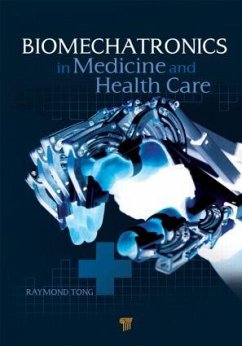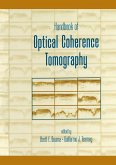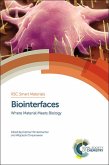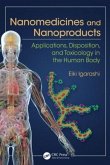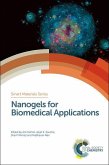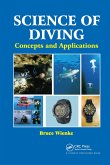Biomechatronics in Medicine and Health Care
Herausgeber: Kaiyu, Raymond Tong
Biomechatronics in Medicine and Health Care
Herausgeber: Kaiyu, Raymond Tong
- Gebundenes Buch
- Merkliste
- Auf die Merkliste
- Bewerten Bewerten
- Teilen
- Produkt teilen
- Produkterinnerung
- Produkterinnerung
This book presents experts insights into the emerging technologies and developments that are being or will be utilized in the medical profession to meet a variety of clinical challenges. It demonstrates the application of biomechatronics to provide better care and service. It also incorporates new and exciting multidisciplinary areas of research across the medical and engineering fields, such as robotic therapeutic training system for stroke rehabilitation, exoskeletons for daily activities on persons with disability, functional electrical stimulation, and wireless active capsule endoscopy.…mehr
Andere Kunden interessierten sich auch für
![Handbook of Optical Coherence Tomography Handbook of Optical Coherence Tomography]() Brett E. Bouma (ed.)Handbook of Optical Coherence Tomography279,99 €
Brett E. Bouma (ed.)Handbook of Optical Coherence Tomography279,99 €![Biointerfaces Biointerfaces]() Biointerfaces217,99 €
Biointerfaces217,99 €![Mimicking the Extracellular Matrix Mimicking the Extracellular Matrix]() Mimicking the Extracellular Matrix107,99 €
Mimicking the Extracellular Matrix107,99 €![Nanomedicines and Nanoproducts Nanomedicines and Nanoproducts]() Eiki IgarashiNanomedicines and Nanoproducts234,99 €
Eiki IgarashiNanomedicines and Nanoproducts234,99 €![Nanogels for Biomedical Applications Nanogels for Biomedical Applications]() Nanogels for Biomedical Applications199,99 €
Nanogels for Biomedical Applications199,99 €![Designing Hybrid Nanoparticles Designing Hybrid Nanoparticles]() Maria BenelmekkiDesigning Hybrid Nanoparticles107,99 €
Maria BenelmekkiDesigning Hybrid Nanoparticles107,99 €![Science of Diving Science of Diving]() Bruce WienkeScience of Diving92,99 €
Bruce WienkeScience of Diving92,99 €-
-
-
This book presents experts insights into the emerging technologies and developments that are being or will be utilized in the medical profession to meet a variety of clinical challenges. It demonstrates the application of biomechatronics to provide better care and service. It also incorporates new and exciting multidisciplinary areas of research across the medical and engineering fields, such as robotic therapeutic training system for stroke rehabilitation, exoskeletons for daily activities on persons with disability, functional electrical stimulation, and wireless active capsule endoscopy. Each chapter provides substantial background material relevant to the particular subject.
Produktdetails
- Produktdetails
- Verlag: Jenny Stanford Publishing
- Seitenzahl: 250
- Erscheinungstermin: 29. August 2011
- Englisch
- Abmessung: 254mm x 180mm x 18mm
- Gewicht: 612g
- ISBN-13: 9789814241618
- ISBN-10: 981424161X
- Artikelnr.: 33068189
- Herstellerkennzeichnung
- Libri GmbH
- Europaallee 1
- 36244 Bad Hersfeld
- gpsr@libri.de
- Verlag: Jenny Stanford Publishing
- Seitenzahl: 250
- Erscheinungstermin: 29. August 2011
- Englisch
- Abmessung: 254mm x 180mm x 18mm
- Gewicht: 612g
- ISBN-13: 9789814241618
- ISBN-10: 981424161X
- Artikelnr.: 33068189
- Herstellerkennzeichnung
- Libri GmbH
- Europaallee 1
- 36244 Bad Hersfeld
- gpsr@libri.de
Dr. Raymond Tong Kaiyu received his PhD in bioengineering from the University of Strathclyde, Glasgow, UK, in 1998. He joined the Hong Kong Polytechnic University in 1999 and the Department of Health Technology and Informatics as an associate professor in 2008. His research interests include rehabilitation robot and functional electrical stimulation system for persons who have suffered stroke. His research and innovation have received Faculty Award on Research and Scholarly Activities(FHSS, PolyU) in 2009; Grand Award from HKIE innovation awards for young members(The Hong Kong Institute of Engineers) in 2008; Gold award from Brussels Eureka 2007 (also known as the 56th World Exhibition of Innovation, Research and Industrial Innovation); Gold award from the 5th China International Invention Exhibition 2004; and Certificate of Merit in Consumer Product Design from the Hong Kong Award for Industry 2003. He teaches subjects related to bioinstrumentation, medical devices, clinical electrophysiology, medical device regulatory (FDA, ISO, MDD), and intellectual property (Patent).
An Introduction to Biomechatronics. What is Biomechatronics? Why Study
Biomechatronics? Conclusions. A Wearable Exoskeletal Rehabilitation Robot
for Interactive Therapy. Introduction. What is Robot-Assisted
Rehabilitation? Review of Rehabilitation Robots for the Upper-Extremity.
Robotic Upper-extremity Repetitive Trainer-RUPERT. Robot Controller and
Therapy Modes. A Virtual Reality-Based Biofeedback Interface. Clinical
Study. Conclusion. Development of Gait-Assisted Robot WPAL (Wearable
Power-Assist Locomotor) for Paraplegia. Introduction. Overview of Gait
Reconstruction of Sci With Orthoses. Introduction of Walking Ability and
Prediction of Walking Ability of Primewalk. Limitation of Orthosis and
Future of Robotics. Advantages to Introduce Robotics to Sci Gait
Reconstruction. Conclusion. Robot-Assisted Rehabilitation of Hand Function
After Stroke with the HapticKnob and the Hand CARE. Introduction. Hand
function after stroke. Robot-assisted Rehabilitation of Hand Function.
Promises of robot-assisted therapy of hand function. Conclusions. A Novel
Continuous Intention-Driven Rehabilitation Robot and Its Training
Effectiveness. Introduction. Rehabilitation Robotic System with Continuous
Intention Driven Control. Evaluation on Training Effectiveness.
Conclusions. Future Studies. Acknowledgement. Hand Rehabilitation Robot
using Electromyography. Introduction to Rehabilitation Robots. Design of
the Hand Rehabilitation Robot. Experiment Procedure. Pilot Clinical
Evaluation of Hand Functions of ELDERLY and Stroke Subjects. Conclusion.
Acknowledgement. Functional Electrical Stimulation Leg Exercise: From
Technology to Therapy. Introduction. Exercise for People with Neurological
Disabilities. Electrical Stimulation of Muscles. Fes-Evoked Exercise.
Technical Development of Fes Exercise Machines. Conclusions. Combined
Functional Electrical Stimulation (FES) and Robotic System Driven by User
Intention for Post-Stroke Wrist Rehabilitation. Introduction. The Combined
Fes-Robot System. System Performance Evaluation. Fes-Robot Assisted Wrist
Training. Conclusions. Acknowledgement. Development of Robots for Active
Rehabilitation of the upper Limbs on the Transverse Plan for Stroke
Patients. Introduction. Our Planar Rehab Robot for Upper Limbs. Evaluation
of Benefits for Rehabilitation with Robots. Future Development.
Conclusions. Upper Extremity Rehabilitation Systems and Augmented Feedback.
Introduction. Stroke Rehabilitation Therapy. Robotic Devices. Augmented
Feedback. Conclusions. Isokinetic Exercise Machine Using High Performance
MR Fluid Brake and Iso-Contraction Exercise. Introduction. Conventional
Isokinetic Exercise & Proposed Iso-contraction Exercise. Experimental
Setup. Isokinetic Exercise. Iso-Contraction Exercise. Conclusions.
Robotic-Assisted Technology for Medical Training Purposes. Motor Control
and Learning. Recent Advances in Medical Training. Assessment of Clinical
Competence as an Approach to Provide Quantitative Information. Reproduction
of Task Conditions as an Approach to Provide Multimodal Feedback.
Conclusions. Wireless Active Capsule Endoscope: State-of-the-Art and
Challenges. Introduction. Major Working Wireless Capsule Endoscope.
Wireless Active Capsule Endoscope. Conclusion and Future Prospect. Color
Inserts. Index
Biomechatronics? Conclusions. A Wearable Exoskeletal Rehabilitation Robot
for Interactive Therapy. Introduction. What is Robot-Assisted
Rehabilitation? Review of Rehabilitation Robots for the Upper-Extremity.
Robotic Upper-extremity Repetitive Trainer-RUPERT. Robot Controller and
Therapy Modes. A Virtual Reality-Based Biofeedback Interface. Clinical
Study. Conclusion. Development of Gait-Assisted Robot WPAL (Wearable
Power-Assist Locomotor) for Paraplegia. Introduction. Overview of Gait
Reconstruction of Sci With Orthoses. Introduction of Walking Ability and
Prediction of Walking Ability of Primewalk. Limitation of Orthosis and
Future of Robotics. Advantages to Introduce Robotics to Sci Gait
Reconstruction. Conclusion. Robot-Assisted Rehabilitation of Hand Function
After Stroke with the HapticKnob and the Hand CARE. Introduction. Hand
function after stroke. Robot-assisted Rehabilitation of Hand Function.
Promises of robot-assisted therapy of hand function. Conclusions. A Novel
Continuous Intention-Driven Rehabilitation Robot and Its Training
Effectiveness. Introduction. Rehabilitation Robotic System with Continuous
Intention Driven Control. Evaluation on Training Effectiveness.
Conclusions. Future Studies. Acknowledgement. Hand Rehabilitation Robot
using Electromyography. Introduction to Rehabilitation Robots. Design of
the Hand Rehabilitation Robot. Experiment Procedure. Pilot Clinical
Evaluation of Hand Functions of ELDERLY and Stroke Subjects. Conclusion.
Acknowledgement. Functional Electrical Stimulation Leg Exercise: From
Technology to Therapy. Introduction. Exercise for People with Neurological
Disabilities. Electrical Stimulation of Muscles. Fes-Evoked Exercise.
Technical Development of Fes Exercise Machines. Conclusions. Combined
Functional Electrical Stimulation (FES) and Robotic System Driven by User
Intention for Post-Stroke Wrist Rehabilitation. Introduction. The Combined
Fes-Robot System. System Performance Evaluation. Fes-Robot Assisted Wrist
Training. Conclusions. Acknowledgement. Development of Robots for Active
Rehabilitation of the upper Limbs on the Transverse Plan for Stroke
Patients. Introduction. Our Planar Rehab Robot for Upper Limbs. Evaluation
of Benefits for Rehabilitation with Robots. Future Development.
Conclusions. Upper Extremity Rehabilitation Systems and Augmented Feedback.
Introduction. Stroke Rehabilitation Therapy. Robotic Devices. Augmented
Feedback. Conclusions. Isokinetic Exercise Machine Using High Performance
MR Fluid Brake and Iso-Contraction Exercise. Introduction. Conventional
Isokinetic Exercise & Proposed Iso-contraction Exercise. Experimental
Setup. Isokinetic Exercise. Iso-Contraction Exercise. Conclusions.
Robotic-Assisted Technology for Medical Training Purposes. Motor Control
and Learning. Recent Advances in Medical Training. Assessment of Clinical
Competence as an Approach to Provide Quantitative Information. Reproduction
of Task Conditions as an Approach to Provide Multimodal Feedback.
Conclusions. Wireless Active Capsule Endoscope: State-of-the-Art and
Challenges. Introduction. Major Working Wireless Capsule Endoscope.
Wireless Active Capsule Endoscope. Conclusion and Future Prospect. Color
Inserts. Index
An Introduction to Biomechatronics. What is Biomechatronics? Why Study
Biomechatronics? Conclusions. A Wearable Exoskeletal Rehabilitation Robot
for Interactive Therapy. Introduction. What is Robot-Assisted
Rehabilitation? Review of Rehabilitation Robots for the Upper-Extremity.
Robotic Upper-extremity Repetitive Trainer-RUPERT. Robot Controller and
Therapy Modes. A Virtual Reality-Based Biofeedback Interface. Clinical
Study. Conclusion. Development of Gait-Assisted Robot WPAL (Wearable
Power-Assist Locomotor) for Paraplegia. Introduction. Overview of Gait
Reconstruction of Sci With Orthoses. Introduction of Walking Ability and
Prediction of Walking Ability of Primewalk. Limitation of Orthosis and
Future of Robotics. Advantages to Introduce Robotics to Sci Gait
Reconstruction. Conclusion. Robot-Assisted Rehabilitation of Hand Function
After Stroke with the HapticKnob and the Hand CARE. Introduction. Hand
function after stroke. Robot-assisted Rehabilitation of Hand Function.
Promises of robot-assisted therapy of hand function. Conclusions. A Novel
Continuous Intention-Driven Rehabilitation Robot and Its Training
Effectiveness. Introduction. Rehabilitation Robotic System with Continuous
Intention Driven Control. Evaluation on Training Effectiveness.
Conclusions. Future Studies. Acknowledgement. Hand Rehabilitation Robot
using Electromyography. Introduction to Rehabilitation Robots. Design of
the Hand Rehabilitation Robot. Experiment Procedure. Pilot Clinical
Evaluation of Hand Functions of ELDERLY and Stroke Subjects. Conclusion.
Acknowledgement. Functional Electrical Stimulation Leg Exercise: From
Technology to Therapy. Introduction. Exercise for People with Neurological
Disabilities. Electrical Stimulation of Muscles. Fes-Evoked Exercise.
Technical Development of Fes Exercise Machines. Conclusions. Combined
Functional Electrical Stimulation (FES) and Robotic System Driven by User
Intention for Post-Stroke Wrist Rehabilitation. Introduction. The Combined
Fes-Robot System. System Performance Evaluation. Fes-Robot Assisted Wrist
Training. Conclusions. Acknowledgement. Development of Robots for Active
Rehabilitation of the upper Limbs on the Transverse Plan for Stroke
Patients. Introduction. Our Planar Rehab Robot for Upper Limbs. Evaluation
of Benefits for Rehabilitation with Robots. Future Development.
Conclusions. Upper Extremity Rehabilitation Systems and Augmented Feedback.
Introduction. Stroke Rehabilitation Therapy. Robotic Devices. Augmented
Feedback. Conclusions. Isokinetic Exercise Machine Using High Performance
MR Fluid Brake and Iso-Contraction Exercise. Introduction. Conventional
Isokinetic Exercise & Proposed Iso-contraction Exercise. Experimental
Setup. Isokinetic Exercise. Iso-Contraction Exercise. Conclusions.
Robotic-Assisted Technology for Medical Training Purposes. Motor Control
and Learning. Recent Advances in Medical Training. Assessment of Clinical
Competence as an Approach to Provide Quantitative Information. Reproduction
of Task Conditions as an Approach to Provide Multimodal Feedback.
Conclusions. Wireless Active Capsule Endoscope: State-of-the-Art and
Challenges. Introduction. Major Working Wireless Capsule Endoscope.
Wireless Active Capsule Endoscope. Conclusion and Future Prospect. Color
Inserts. Index
Biomechatronics? Conclusions. A Wearable Exoskeletal Rehabilitation Robot
for Interactive Therapy. Introduction. What is Robot-Assisted
Rehabilitation? Review of Rehabilitation Robots for the Upper-Extremity.
Robotic Upper-extremity Repetitive Trainer-RUPERT. Robot Controller and
Therapy Modes. A Virtual Reality-Based Biofeedback Interface. Clinical
Study. Conclusion. Development of Gait-Assisted Robot WPAL (Wearable
Power-Assist Locomotor) for Paraplegia. Introduction. Overview of Gait
Reconstruction of Sci With Orthoses. Introduction of Walking Ability and
Prediction of Walking Ability of Primewalk. Limitation of Orthosis and
Future of Robotics. Advantages to Introduce Robotics to Sci Gait
Reconstruction. Conclusion. Robot-Assisted Rehabilitation of Hand Function
After Stroke with the HapticKnob and the Hand CARE. Introduction. Hand
function after stroke. Robot-assisted Rehabilitation of Hand Function.
Promises of robot-assisted therapy of hand function. Conclusions. A Novel
Continuous Intention-Driven Rehabilitation Robot and Its Training
Effectiveness. Introduction. Rehabilitation Robotic System with Continuous
Intention Driven Control. Evaluation on Training Effectiveness.
Conclusions. Future Studies. Acknowledgement. Hand Rehabilitation Robot
using Electromyography. Introduction to Rehabilitation Robots. Design of
the Hand Rehabilitation Robot. Experiment Procedure. Pilot Clinical
Evaluation of Hand Functions of ELDERLY and Stroke Subjects. Conclusion.
Acknowledgement. Functional Electrical Stimulation Leg Exercise: From
Technology to Therapy. Introduction. Exercise for People with Neurological
Disabilities. Electrical Stimulation of Muscles. Fes-Evoked Exercise.
Technical Development of Fes Exercise Machines. Conclusions. Combined
Functional Electrical Stimulation (FES) and Robotic System Driven by User
Intention for Post-Stroke Wrist Rehabilitation. Introduction. The Combined
Fes-Robot System. System Performance Evaluation. Fes-Robot Assisted Wrist
Training. Conclusions. Acknowledgement. Development of Robots for Active
Rehabilitation of the upper Limbs on the Transverse Plan for Stroke
Patients. Introduction. Our Planar Rehab Robot for Upper Limbs. Evaluation
of Benefits for Rehabilitation with Robots. Future Development.
Conclusions. Upper Extremity Rehabilitation Systems and Augmented Feedback.
Introduction. Stroke Rehabilitation Therapy. Robotic Devices. Augmented
Feedback. Conclusions. Isokinetic Exercise Machine Using High Performance
MR Fluid Brake and Iso-Contraction Exercise. Introduction. Conventional
Isokinetic Exercise & Proposed Iso-contraction Exercise. Experimental
Setup. Isokinetic Exercise. Iso-Contraction Exercise. Conclusions.
Robotic-Assisted Technology for Medical Training Purposes. Motor Control
and Learning. Recent Advances in Medical Training. Assessment of Clinical
Competence as an Approach to Provide Quantitative Information. Reproduction
of Task Conditions as an Approach to Provide Multimodal Feedback.
Conclusions. Wireless Active Capsule Endoscope: State-of-the-Art and
Challenges. Introduction. Major Working Wireless Capsule Endoscope.
Wireless Active Capsule Endoscope. Conclusion and Future Prospect. Color
Inserts. Index

